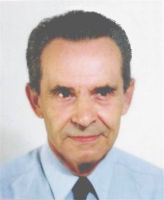
|
|
|
|
 |
Zvonko Ogorelec in memoriam(1930 -2003)
|
Professor Zvonko Ogorelec was a very successful physicist in several branches of solid-state physics, very much respected university professor at the undergraduate and graduate level and very active writer of popular scientific articles.
Professor Zvonko Ogorelec was born in Zagreb, Croatia, on 29 May 1930. He completed his primary and secondary education in his home town where he entered in the autumn of 1950 the study of physics at the Faculty of Science and Mathematics of the University of Zagreb. During the study, he was employed part-time as a technician in the Physics Department where he participated, together with B. Saftić, in the construction of various instruments for the student laboratories. He graduated in 1955 and was employed in 1957 in the Laboratory for Electron Microscopy of the "R. Bošković" Institute in Zagreb where he started his research work with Professor Z. Devidé. Soon after, he changed his position to work with Professor M. Varićak, head of the Laboratory for semiconductors in the "R. Bošković" Institute. In this Laboratory, he made many of his experimental investigations of various effects in semiconductors, mostly of the I-VI type. During that time, he went to the laboratory of the Polish Academy of Science led by Professor L. Sosnowski, who was a leading specialist for the research in synthesis of semiconductor compounds and production of semiconductor monocrystals. In 1959, he changed his permanent working position after he was elected to the position of the assistant in the Physics Department of the Faculty of Science and Mathematics of the University of Zagreb, but continued his research work in the Laboratory for semiconductors, later Department of Solid State Physics in the "R. Bošković" Institute, as part-time associate.
When the newly built Institute of Physics of the University of Zagreb was completed around 1967, he founded there the Department for Semiconductors and was the head of the Department for several years. As part-time collaborator, he continued there his research work on properties of semiconductor compounds.
Since 1959, Professor Ogorelec was actively engaged in teaching at the Faculty of Science and Mathematics. He was also very active in the construction of instruments and in setting up of student laboratory exercises, organizing of new student laboratories and in writing, together with Professor M. Paić, of textbooks for the work of students in the laboratories. He was elected to the position Dozent (Assistant Professor) in 1968, Associate Professor in 1973 and Professor in 1983. He taught several undergraduate and graduate courses, some of them introduced by him: Experimental Techniques in Physics, Physics of Materials, and Semiconductor Physics, and was in charge of the Student Physics Laboratories I, II, III and IV, of the Higher Physics Laboratory and of the Solid State Physics Laboratory. Under his supervision, about 30 students made their diploma theses, seven graduates completed their masters theses and 2 their doctoral theses.
After the new building of the Physics Department of the University of Zagreb was built in 1991, he formed the Laboratory for Semiconductors in the Department where he continued his research work even after retirement in the autumn 2000, as Professor Emeritus, until the end of his life in 2003.
As mentioned above, the main results in the research work of Professor Ogorelec are related to semiconductor physics. A good impression of that work may be obtained by reading the titles of scientific articles in the list below. Of course, even better by reading the articles.
Professor Ogorelec was among the very first scientists, both in Croatia and worldwide, who in the early sixties started investigations of superionic conductors, both of the pure ionic conductors (silver halogenides) and of the mixed electronic-ionic conductors (copper and silver chalcogenides). Today, the superionic conductors form the basis of the technology of energy conservation, as well as of other important applications, to mention just the sensors. The sensors were Professor Ogorelec's obsession, he had repeatedly returned his scientific interest to them, and on many occasions he succeeded to develop them to the application level.
In his work on superionic conduction, Professor Ogorelec drew attention of the research community with two articles. In his article in J. Phys. Chem. Solids 30 (1969) 149, he gave a simple model for the explanation of the complex dependence of conductivity of Cu-Se on temperature and stoichiometry that proved to be valid and is generally accepted. In the article in Europhys. Lett. 46 (1999) 56, he discovered an unexpectedly high value of the magnetoresistance of Ag2Se, which revived research interest for this compound.
Professor Ogorelec had a very close collaboration with the electronic industry in Zagreb. He worked with the designers of semiconductor devices in their department for new electronic components. In that work, his broad knowledge and great practical experience resulted in many practical semiconductor devices. In this way, he promoted many new products, some of which can still be found on the market. One such product of the electronic industry, developed at the end of the seventies, is the linear semiconductor temperature sensor, used for measurement and for control in the range -50° to 350° that has excellent performance.
Professor Ogorelec published 50 original articles in scientific journals, 23 articles in conference proceedings of which 4 were invited talks, 5 university textbooks (these are listed below), 35 short conference contributions (published as abstracts), 13 articles in technical journals and 73 articles popularizing science.
For his research work, Professor Ogorelec received the Prize for Science of the Town of Zagreb in 1976 and the Prize for Science "R. Bošković" of the Republic of Croatia in 1989. For his work on popularization of science he received the Prize of Republic of Croatia in 1994.
Editors
Copyright by The Croatian Physical Society
|